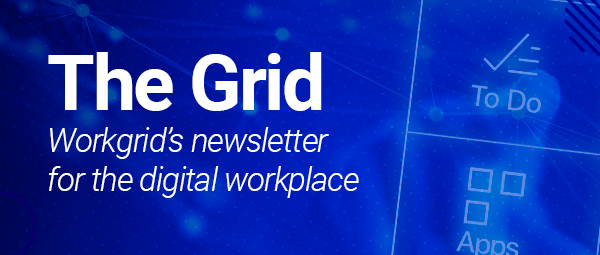Digital employee experiences designed for the future of work
If there's one thing the shifting nature of work throughout the pandemic has taught us, it's how important the digital employee experience is. It is not enough for technology to just facilitate work. It also needs to create modern, intelligent experiences that increase productivity, drive engagement, and give employees the flexibility they need to manage their work and personal lives more effectively.
Successfully navigating the future of work will require organizations to provide employees with modern, flexible digital experiences.
![[asset] employee-laptop-stock-photo](https://images.ctfassets.net/z7p73u8c0thn/7KigzkaXkEn5fECnbIJsck/15b99a6509a420718e6d0aac8d0e049b/laptop-958239_640.jpg?w=640&h=423&fl=progressive&q=60&fm=jpg&bg=transparent)
Successfully navigating the future of work will require organizations to provide employees with modern, flexible digital experiences.
That might sound like an impossibly tall order, but it doesn't have to be. Better digital employee experiences are easily achievable if you're willing to take the first step - thinking about things a little differently and focusing on what kinds of experiences employees need to be successful. The reality is, the smallest changes often have the biggest impact. That's why I suggest starting by reimagining some of the little experiences employees encounter, such as with these three use case examples...
3 digital employee experiences you can improve right now
Example 1: Scheduling vacation time
Unused vacation time is a liability that costs organizations big time, both in bottom line dollars and lost productivity. Thankfully, everyone agrees that employee wellness is a growing priority and that it’s more important than ever before to rest and recharge. But the reality is, scheduling time off isn’t always as easy as it could be. It’s a process that involves numerous of steps in multiple systems, with covid-19 policies and procedures making things even more challenging.
![[asset] unused-vacation-time-600x350](https://images.ctfassets.net/z7p73u8c0thn/2Xy9CAdZy7XEYLtNc3oCH1/10b80192b2a625026f4d5e88fad5515b/unused-vacation-time-600x350.png?w=600&h=350&q=60&fm=png&bg=transparent)
To avoid burnout, employees should be actively encouraged to take the vacation time they have coming to them. It’s isn’t just imperative for their well-being, it’s good for business.
To avoid burnout, employees should be actively encouraged to take the vacation time they have coming to them. It’s isn’t just imperative for their well-being, it’s good for business.
Streamlining this task might seem like an impossibility. The process is what it is, right - how could it possibly be simplified? But this is where considering the “art of possible” becomes critically important. Set aside the old way of thinking and start considering “what if?”
What if requesting vacation time could be easier? Well it can be. In fact, it can be much easier (like 1-2 steps instead of many). How? With the use of a employee experience layer.
Digital experience layers separate the user experience from underlying source systems, giving organizations the flexibility to control and design experiences that meet employees’ need by helping them fulfill their intent - all while maintaining investments in the best-of-breed business applications that keep business running. You can think of digital experience layers like a digital assistant that integrates with all enterprise systems on behalf of employees, shielding them from complexity and delivering just the seamless experience they expect.
With that in mind, here’s how requesting vacation time should work…
A modern digital employee experience means using outcome-driven design to complete routine tasks in fewer steps.
A modern digital employee experience means using outcome-driven design to complete routine tasks in fewer steps.
Example 2: Managing enterprise IT costs
The pandemic has had many unintended consequences, like the fact that when the quarantine started, most workers set themselves up with a space to work at home, plugged in their laptops and never gave it another thought. That was a problem because laptops aren’t meant to stay fully charged. They’re meant to be discharged regularly, and when they aren’t, bad things can happen, like the issue I call “fat battery” where a constantly charged battery starts to swell and eventually splits.
While it’s tempting to file this issue under “stuff happens” and relegate It to the long list of things you couldn’t possibly do anything about, I’d encourage you to rethink that position. It’s not cost-effective to replace laptops frequently (especially when it could have been avoided) and laptops have become increasingly expensive over the past year, not to mention more difficult to even get due to chip shortages.
Thankfully, it’s both easy to help employees know what to do if this issue does happen to them, as well as to head it off at the pass entirely.
There are two very important steps you could take, starting with sending employees proactive notifications to remind them to periodically take their laptops on a little walking tour of their house so the batteries have a chance to run down. You can also make it easier to order new equipment if the worst-case-scenario does happen. Here’s how…
A modern digital employee experience means using outcome-driven design to complete routine tasks in fewer steps.
Example 3: Ordering office equipment to work from home
In the beginning of the pandemic, when it wasn’t clear how long the quarantine would last, working from whatever flat surface would hold a laptop seemed reasonable. But as days turned into weeks and months, it became clear that ergonomics wasn’t just a fancy buzzword that HR threw around to sound important. With kinked necks, sore backs and in some cases, increasingly debilitating physical conditions, employees accepted the fact that a better seating arrangement was a must-have rather than a nice-to-have. And so the search for office chairs began.
![[asset] work-from-home-equipment-600x350](https://images.ctfassets.net/z7p73u8c0thn/2ovsc0sgFTvD1fp0eV6tcP/76efddbe040aa75b357bc918f4923831/work-from-home-equipment-600x350.png?w=600&h=350&q=60&fm=png&bg=transparent)
Making it easy for employees to get the resources they need to work effectively is an investment that will pay significant long-term dividends.
Making it easy for employees to get the resources they need to work effectively is an investment that will pay significant long-term dividends.
But ordering office equipment wasn’t always easy. Most workers just assumed that they wouldn’t be allowed to get an appropriate chair and while a few chased down permission for one, they were thwarted at every turn and usually just ended up buying one for themselves.
This is the kind of poor employee experience that can make workers feel as though their needs aren’t important. It can be the tipping point that makes them look for other employment options. You can avoid that kind of costly situation with clear communication and self-service technology. Here’s how…
Better digital experiences = a more effective future of work
The bottom line is, to handle the future of work (which is already here, by the way), you need to be able to react to employee problems quickly, solving them by deploying intelligent new experiences that are focused on solutions, rather than silo-ing employee in technology stacks. It’s doable, easy and can be accomplished using without replacing any of your existing technology.
To learn more, check out this on-demand session, “The Intranet and the Digital Work Experience of the Future.”
Originally presented at Intra.Net Reloaded USA, Workgrid's Director of Partner Strategy, Frank Pathyil, discusses the changes organizations must face in a post-pandemic world and the impact an innovative intranet and an experience layer can have in supporting long-term success.



